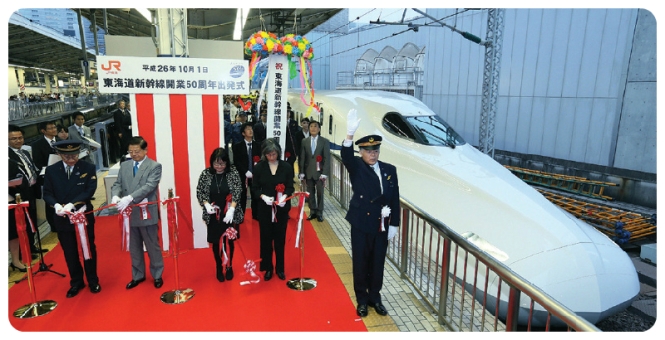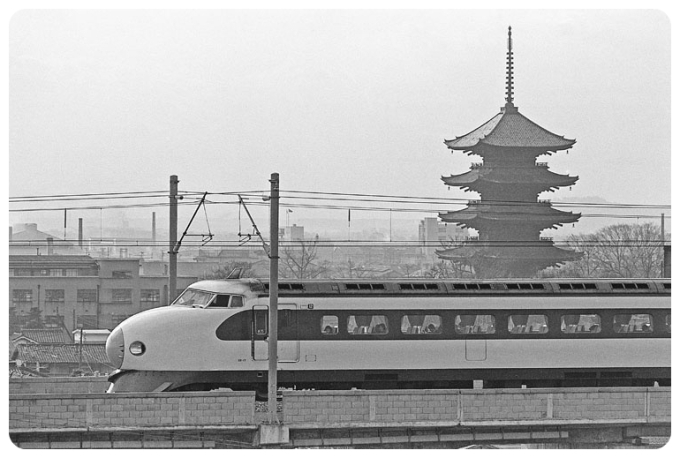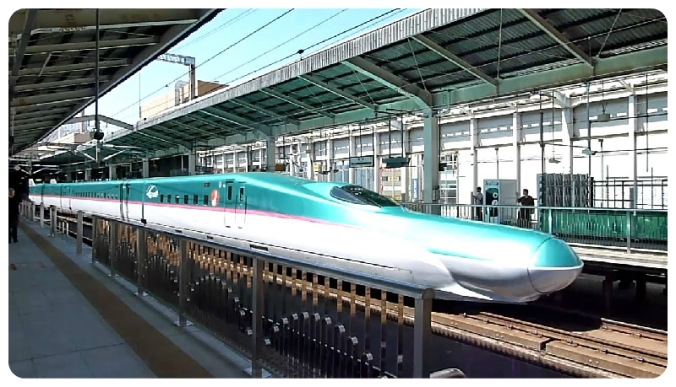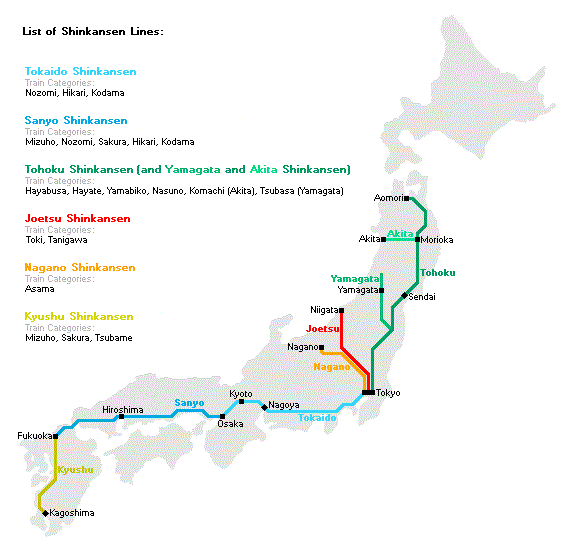On October 1st this year, there was a re-enactment of the inauguration ceremony of the Shinkansen or the Japanese Bullet Train. The Shinkansen was born exactly 50 years ago. If there was a single event that signalled the arrival of Japan as an economic superpower and an engineering giant, this was it.
The High-speed Dream
The term ‘Shinkansen’ first popped up in 1940 when high speed passenger and freight lines were proposed between Tokyo and Shimonoseki . However, all plans were dropped with the devastation that followed the World War. Slowly during the reconstruction, any thought of a high speed rail service began to disappear, with the mindset that the better highways and flights would suit Japan’s logistic needs.
With Japan being awarded the 1964 Olympics, a number of large-scale projects were undertaken for the milestone event. People began to flood the cities in conjunction with the Olympics and the existing railway facilities couldn’t keep up with demand. In 1958, under the persistence of Shinji Sogo, the then president of the Japanese National Railways, the Shinkansen project got the green light. Flush with 200 billion Yen and an $80 million loan from the World Bank, Shinji began to assemble a formidable team with the likes of Hideo Shima (Chief engineer), Tadanao Miki, Tadashi Matsudaira. The goal was to achieve a high speed rail line capable of travelling in excess of 200kmph and topple the speed record held by the French Mistral (top speed : 160kmph).
From the beginning, the project was filled with technical obstacles and this was where the Japanese engineers came through. Tadanao Miki was brought in to handle design, (his previous work included designing the dreaded kamikaze fighter planes!). His work with aircrafts resulted in the streamlined jet-like design of the Shinkansen we have come to know and admire. Tadashi Matsudaira was in charge of mitigating the phenomenon known as Hunting’s Oscillation. When a traditional railway wheel moves at high speeds it begins to vibrate horizontally; with the Shinkansen’s goal of 200kmph, the vibrations posed a serious threat of derailment. After much research Tadashi came up with the revolutionary air spring capable of damping vibrations, both vertical and horizontal.
Hard work bore fruit on March 30th 1963 with a successful trial run and a top speed of 256kmph. But success came at a price with the project costing nearly 400 billion yen— roughly twice the allocated budget. In traditional Japanese style, both Shinji Sogo and Hideo Shima resigned taking responsibility for the overrun. Tadanao Miki also resigned, announcing that he had nothing more to contribute to the project. The Shinkansen opened its doors to the public on October 1, 1964 just in time for the Tokyo Olympics. The Tokaido Shinkansen (first high speed rail line) plied between Tokyo and Osaka; the journey that usually took 6:30 hours, was reduced to a mere 4 hours. For the Japanese people rebuilding the country after World War II, the Shinkansen served as a great source of inspiration.
The Engineering Marvel
In its fifty years of service there hasn’t been a single accident – a marvelous testament to Japanese engineering. It has achieved everything concerning Speed, Precision and Safety:
Speed: With the aerodynamic design more in line with a jet fighter the first generation Shinkansen travelled at speeds close to 220kmph. Today’s Shinkansen travel at speeds in excess of 300kmph.
Precision: Picture the NASA control center: that’s pretty close to the control center of the Shinkansen network. A network of computers procuring data in real time are carefully monitored by trained staff; nothing is left to chance. So precise is the network that the worst case scenario for the shinkansen is arriving late or early by a mere 10 seconds (on average).
Safety: Travelling nonstop at high speeds means there no place for signals; so, in its place a unique system is employed – The ATC (Automatic Train Control System). The ATC divides tracks into 1km segments, each segment being monitored to ensure no train is within 1km of another. If that were to occur, a signal is sent to the train behind to slow down; and if that fails a kill switch is activated bringing the train to a halt. So far the system has never failed.
What the Shinkansen delivered
Has the investment in the Shinkansen yielded real dividends? Absolutely! If we study Dr. Hiroshi Okada’s (President of Japanese Railway Technical Service) research you’ll see that Shinkansen has done enough and more. Let’s look at the key benefits:
Reduced travel time: Dr. Okada used a method to quantify time saved in monetary terms and the results are quite interesting. If 85% of the total passengers on the present four shinkansen lines shifted to conventional lines, the time lost would be approximately 400 million hours. By calculating the value of the time per hour from the GDP per capita, the value of the commuters’ time saving is approximately ¥ 500 billion per year!
Economic growth: Construction of the Shinkansen has had a spillover effect – employment opportunities were generated, population grew in regions served, tourism flourished and least expected were people (with reference to Kakegawa city on the Tokaido Shinkansen line) living culturally richer lives thanks to being connected to metropolitan cities.
Greener transportation: Okada’s research showed something else: per passenger-mile of transport, automobiles would consume 4.6 times more fuel than the Shinkansen (aircraft would consume 5.3 times more). If the Tokaido Shinkansen had not been constructed Japan would have consumed 360 million more litres of oil by 1985! This means a lot to a country like Japan which depends heavily on oil imports. That’s not all. If the Tokaido Shinkansen had not been constructed, there would have been 15000 tons more of CO2 emissions by 1985.
Since 1964 the Shinkansen has carried over 10 billion passengers and expanded its network coverage. Despite Japan’s varied landscape (mountainous terrain, only 20% of Japan’s land area is habitable) and constant barrage of natural disasters the network extends all the way up north to Aomori in Honshu and down south to Kagoshima in Kyushu. What the Shinkansen has done is make Japan smaller, most cities are connected by it and probably in the process made Tokyo a bigger city than it already is.
The Future
If you thought travelling at around 300kmph wasn’t fast enough, the Japanese Railways made plans for maglev (magnetic levitation) version of the Shinkansen. Initially connecting Tokyo to Nagoya by 2027 it will have a subsequent extension to Osaka by 2045. Travelling speeds will be upwards of 500kmph making it the fastest train in the world. But the catch is that the tracks have to be straight — considering Japan’s landscape, most of the line will be built underground taking away the charm of scenic routing. The whole project is estimated at ¥9 trillion. One may ask, with air travel becoming cheaper is it all a vanity project? I wonder what Shinji Sogo would say !
Please do COMMENT and share your thoughts, I would love to hear from you!







Thanks for the article. I have taken the shinkansen several times, and have enjoyed it immensely. Thanks to the Japan Rail Pass, I have traveled from Tokyo to Osaka, as well as most of the way to Nagasaki.
Of course, I love trains, and would have also taken the “twilight express”–slower, but still interesting. Sadly, I believe the service is discontinued.
LikeLike
You’re welcome. Must be nice to ride the Shinkansen, though I’ve heard it’s awfully expensive.
LikeLike
If you get the railpass, it is much more economical. It costs about the same as a return trip from Tokyo to Osaka, but its good for a week, or two.
LikeLike
I enjoyed your article.
Being a maglev veteran and transportation consultant from America, I’ve been fortunate to have ridden up front in the driver’s compartment for a few minutes on a Shinkansen trip from Tokyo to Nagoya a couple of years ago. That was an experience. But it was exceeded by riding on the prototype “Chuo Shinkansen” superconducting maglev train at 500 km/h at the Yamanashi test facility later in the same week. Truly phenomenal technology.
Best of luck in Japan — and in the United States — in constructing the world’s fastest and safest trains.
LikeLiked by 1 person
Thank you for writing in. You must be leading an exciting life– riding all the super trains. I heard that the Japanese are selling the Maglev concept outside Japan as well. You might know about this better than I do. Do share your insights.
LikeLike
Yes, I guess I have been leading an exciting consulting life — trying to get a maglev-related project in the USA since the late 1908s has allowed me to work in large aerospace companies, national research laboratories and small consulting firms before becoming the main technical rep for the German Transrapid group’s office in Washington D.C. from 1999 to 2005. After leaving that group I became an independent consultant and eventually worked for a Japanese start-up group in D.C. called U.S.-Japan Maglev (now called “The Northeast Maglev”) for three-plus years, from 2010 until about a year ago.
The TNEM group is trying get a superconducting maglev built along the eastern coast of the U.S., first connecting Washington to Baltimore, Maryland and then going on to New York City. It’s similar to the current Chuo Shinkansen construction plan, but not as predictable due to our politics. I hope for the best, though, because they’re doing everything right as far as I can see.
All during this time I’ve been fortunate enough to ride most of the world’s super trains, as you say, in Europe and Asia,including the high-speed Shanghai maglev, the Yamanashi prototype and, in 2011, the Korean urban maglev for Incheon airport. So far I’ve missed the Linimo urban maglev in Nagoya, but it’s definitely on my list.
LikeLike
Pingback: Introducing the New Tokaido Line – Hyde Park Now!
Pingback: Introducing the New Tokaido Line – Hyde Park Now!